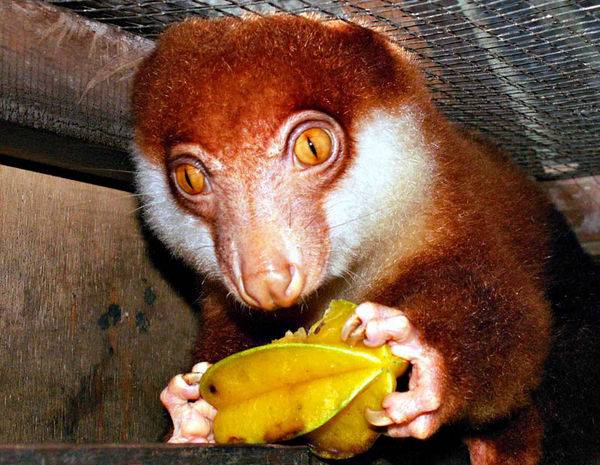|

Cuscus eating star fruit. This image used to be on our Spotted Cuscus page. However it has been moved after received an email from Roy Nielsen who advised that "it shows the very rare Spilocuscus rufoniger. This species is only found in northern New Guinea (for a detailed overview of this species, see 'Mammals of New Guinea' by Tim Flannery)."
Photograph copyright: Michael Thirnbeck - all rights reserved. Used with permission.
|
|
|
MAMMAL FACTS |
Description
The Black-spotted Cuscus is one of the largest species of cuscus. Females are larger than males. The body is reddish. Females have a dark saddle on their backs, and males have an area of dark mottling or spots. The fur is dense and wooly. Black-spotted Cuscus have round heads and short snouts, and ears are almost invisible. The eyes are large and well adapted for their nocturnal lifestyle. Their front claws are curved with sharp points for climbing. Black-spotted cuscus have prehensile tails with bare tip.
Size
Head and body length: 70cm. Tail length: 50cm. Weight: 6kg - 7kg females.
Habitat
tropical forests, thick scrub
Food
Black-spotted cuscus are believed to be omnivorous, feeding on fruit, nuts and perhaps some small animals
Range
northern New Guinea (Note: not found in Australia)

Credits:
Map is from Atlas of Living Australia website at https://biocache.ala.org.au licensed under Creative Commons Attribution 3.0 License.
Notes
threatened by hunting and habitat loss.
Conservation Status
The conservation status in the 2004 IUCN Red List of Threatened Animals is "critically endangered".
Classification
| Class: | Mammalia | | Order: | Diprotodontia | | Family: | Phalangeridae | | Genus: | Spilocuscus | | Species: | rufoniger | | Common Name: | Black-spotted Cuscus |
Relatives in same Genus
Spotted Cuscus (S. maculatus)
|
|

